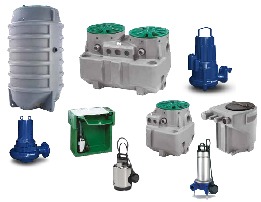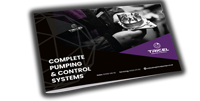PUMPING SOLUTIONS
SELECTING THE RIGHT water BOOSTER pump SET | Tricel
OVERVIEW
Finding a suitable cold water booster set is essential to installing a pressurised system that is fit for purpose. Our experts offer free consultations so you can tell us what you need before you spend a penny. Tricel can offer custom pump designs for any pumping application, including hand, wind, solar, electric, petrol or diesel pumps, for various applications and end-users.
By providing high-quality water pumping solutions for building services, drainage and sewage, irrigation and water utility markets, our core objective is to ensure your water flows smoothly. Manufacturing, pharmaceuticals, chemical processing, and marine are among our niche markets that require specialised knowledge.
If you have any questions, feel free to call us or use our quote form
To speak to one of our agents online, click here
What is a water booster pump set?
Technically, it is a multi-pump skid-mounted system that automatically maintains system pressure and consists of:
- A variable speed drive which is typically used to drive two or more pumps.
- Expansion vessels, manifolds, and valves
- Sensors, control gear, and BMS interface systems.
Booster pump sets are helpful for many applications, from providing water supply pressure to drinking fountains and washrooms to pressurising critical fire suppression systems, irrigation systems, car washes, water treatment systems, industrial processes, and many more. They have two major components: a booster pump and an accumulator tank.
Homes, hospitals, schools, offices, hotels, industrial, and commercial sites can benefit significantly from variable speed booster sets. The modern booster set maximises efficiency, minimizes water consumption, and reduces energy consumption – and can be retrofitted into existing systems.
How does a water booster set work?
A water booster set is a system designed to increase water pressure in buildings or areas where the existing water pressure is insufficient. It typically consists of a pump, a controller, and various accessories. Here’s a basic overview of how a water booster set works:
Water Source: The booster set is connected to a water source, such as a municipal water supply or a well. The water source provides the initial water pressure.
Pump: The heart of the water booster set is the pump. The pump is responsible for increasing the water pressure by drawing water from the source and pushing it into the building’s plumbing system. There are different types of pumps, such as centrifugal pumps, commonly used in booster sets.
Controller: The controller manages the operation of the pump. It monitors the water pressure in the system and activates the pump when the pressure falls below a certain setpoint. Once the pressure reaches the desired level, the controller may turn off or adjust the pump speed to maintain a consistent pressure.
Pressure Sensors: Pressure sensors are placed at strategic points in the plumbing system to measure the water pressure. These sensors provide feedback to the controller, allowing it to make real-time adjustments to the pump operation.
Accumulator Tank (Optional): Some water booster sets include an accumulator tank. This tank acts as a storage buffer for pressurised water, helping to reduce the frequency of pump starts and stops. It also contributes to a more stable and consistent water pressure.
Check Valves: Check valves are installed to prevent water from flowing back into the pump and water source when the pump is not in operation. This ensures that the system maintains pressure and does not lose prime.
Pressure Relief Valve: A pressure relief valve is a safety feature that releases excess pressure from the system, preventing damage to the pump or plumbing components.
In summary, a water booster set works by using a pump and controller to maintain or boost water pressure in a building or water distribution system. The system responds to changes in pressure by activating or adjusting the pump operation, ensuring a reliable and consistent water supply.

Why is a water booster pump set important?
A water booster pump is crucial in the context of water conservation, particularly in the UK where water consumption is high per person, urbanization is increasing, and the potential for extreme heatwaves poses a challenge. Here’s why a water booster pump is important in this scenario:
Water Conservation: Booster sets contribute significantly to water conservation by optimising water usage. They enhance water pressure in buildings, ensuring that the available water is used more efficiently. Adequate pressure reduces the likelihood of excessive water consumption, as users may compensate for low pressure by running water fixtures for longer durations.
Energy Efficiency: Variable speed booster pumps, in particular, are instrumental in saving energy. Unlike standard booster pumps that operate at a constant speed, variable speed pumps adjust their speed based on the required pressure. This adaptability results in energy savings of up to 50%, making them a sustainable and cost-effective choice. Lower energy consumption not only benefits the environment but also leads to financial savings for users.
Cost Savings: The energy efficiency of variable speed boosters translates into direct cost savings for users. By consuming less energy to maintain optimal water pressure, individuals, businesses, and municipalities can reduce their utility bills. This financial incentive encourages the adoption of water booster pump systems, promoting sustainable practices.
Environmental Impact: The reduced water consumption facilitated by booster sets aligns with broader environmental goals. With climate change predictions, including forecasts of extreme heatwaves, the conservation of water resources becomes critical. By minimizing unnecessary water usage, booster pumps contribute to sustainable water management practices, reducing the overall environmental impact.
Intelligent Control for Longevity: The intelligent control systems in modern water booster pumps contribute to the longevity of the equipment. By adjusting pump operation based on real-time demand, these systems reduce wear and tear on components like motor bearings. This not only extends the lifespan of the pump but also reduces the frequency of maintenance and replacements, resulting in additional cost savings.
Reduced Footprint: The use of intelligent controls also allows for a more compact design of the system. Large expansion tanks, which may be necessary in traditional setups, are not required with modern booster pump systems. This reduction in physical footprint is advantageous in space-constrained urban environments and contributes to more efficient use of resources.
In conclusion, water booster pumps, especially variable speed ones with intelligent controls, play a pivotal role in water conservation efforts in the face of increasing water demand, urbanization, and the need for sustainable practices in the UK. Their ability to reduce water consumption, save energy, cut costs, and minimize environmental impact makes them indispensable tools in the preservation of water resources.
PACKAGED PUMPING SETS
Designed to deliver sufficient volume and water pressure
FIRE PUMPS
Full range of Fire Protection Pumps from small to packaged systems
PACKAGED PUMPING STATIONS
Pumping stations offer the ideal solution where gravity drainage is not possible
Choosing the right booster set
In the current era of heightened focus on energy conservation, selecting the appropriate water booster pump set is more crucial than ever. The key to this process lies in accurately identifying essential data. Given that many projects involve making assumptions about this data, it becomes imperative to over-specify the data to ensure the pump system can effectively handle the demand.
- Average Flow Rate Calculation: Determining the optimal number of taps, showers, and other combinations of baths/showers/taps involves a delicate balance between technical and financial considerations. Technically, it revolves around assessing how many people could use the system simultaneously, with industry standards like CIBSE guiding these decisions. Informal surveys or limited trials can also provide valuable insights.
- Calculated Peak Demand Flow Rate: A simple formula calculates the peak demand flow rate: Flow rate = flow quantity/time in seconds. If the project involves staggered shower usage patterns, visiting during different times and days is necessary for accurate numbers. Residential and commercial buildings will exhibit varying demand flow rates; hospitals and hotels will have distinct requirements.
- Static Height Difference: Booster sets are configured to ensure adequate water pressure at the highest outlet. The static height difference is the vertical distance between the supply tank water level and the highest outlet on the system
- Highest Outlet Pressure Required: Building designers ascertain the pressure needed at the highest point. For instance, an upper-floor shower in a three-storey building may require at least 3.0 bar pressure. The duty head pressure is calculated by adding the required pressure to the static height and friction loss figure
- Friction Losses at Peak Flow Rates: The size of interconnecting pipes must be scrutinized, as inadequate pipe size can result in a significant pressure drop. Suitable pipework is essential to deliver the required pressure through the booster system.
- Redundancy for Emergency or Maintenance Cover: Depending on the specified flow rate, one pump may cover the total duty flow or multiple pumps could be equally distributed. Introducing redundancy, such as having three pumps with each handling 50% of the peak flow rate, ensures a 50% backup in case of pump failure, maintaining operational continuity during emergencies or maintenance periods.
PUMP COMMISSIONING
Our skilled team of specialist engineers are ready to specify, supply, install, service and maintain pumps and their control systems
SERVICE & MAINTENANCE
We provide preventative maintenance contracts and also cater for specific repairs, including replacements seals or complete overhauls
SITE SURVEYS & ASSESSMENTS
Our technical team will visit your location and complete an entire site survey to ensure your project is accurately specified, and the most suitable system installed and maintained to the highest quality
CUSTOMER TECHNICAL SUPPORT
Through our 35 years of operation, we have accumulated a wealth of product knowledge and application experience that we use to support our customers
